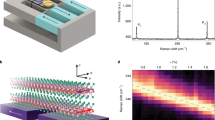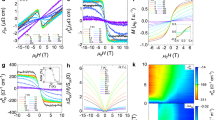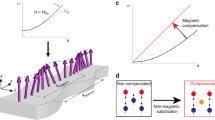Abstract
Recent advances in III1–xMnxV ferromagnetic semiconductors (for example in Ga1–xMnxAs) have demonstrated that electrical control of their spin properties can be used for manipulation and detection of magnetic signals1,2. The Mn2+ ions in these alloys provide magnetic moments, and at the same time act as a source of valence-band holes that mediate the Mn2+–Mn2+ interactions3,4,5. This coupling results in the ferromagnetic phase. In earlier work2,6it was shown that the ferromagnetic state can be enhanced or suppressed by varying the carrier density. Here we demonstrate that, by using hydrostatic pressure to continuously tune the wavefunction overlap, one can control the strength of ferromagnetic coupling without any change in the carrier concentration. Tuning the exchange coupling by this process increases the magnetization spectacularly, and can even induce the ferromagnetic phase in an initially paramagnetic alloy. These results may open new directions for strain-engineering of nanodevices.
This is a preview of subscription content, access via your institution
Access options
Subscribe to this journal
Receive 12 print issues and online access
$259.00 per year
only $21.58 per issue
Buy this article
- Purchase on Springer Link
- Instant access to full article PDF
Prices may be subject to local taxes which are calculated during checkout



Similar content being viewed by others
References
Yamanouchi, M., Chiba, D., Matsukura, F. & Ohno, H. Current-induced domain-wall switching in a ferromagnetic semiconductor structure. Nature 428, 539–542 (2004).
Chiba, D., Yamanouchi, M., Matsukura, F. & Ohno, H. Electrical manipulation of magnetization reversal in a ferromagnetic semiconductor. Science 301, 943–945 (2003).
Ohno, H. Properties of ferromagnetic III–V semiconductors. J. Mag. Magn. Mater. 200, 110–129 (1999).
Ohno, H. Making nonmagnetic semiconductors ferromagnetic. Science 281, 951–956 (1998).
König, J., Schliemann, J., Jungwirth, T. & MacDonald, A. H. in Electronic Structure and Magnetism of Complex Materials (eds Singh, D. J. & Papaconstantopoulos, D. A.) (Springer, Berlin, 2002).
Ohno, H. et al. Electric-field control of ferromagnetism. Nature 408, 944–946 (2000).
Wojtowicz, T. et al. In1–xMnxSb—a narrow-gap ferromagnetic semiconductor. Appl. Phys. Lett. 82, 4310–4313 (2003).
Crepieux, A. & Bruno, P. Theory of the anomalous Hall effect from the Kubo formula and the Dirac equation. Phys. Rev. B 64, 014416 (2001).
Jungwirth, T., Niu, Q. & MacDonald, A. H. Anomalous Hall effect in ferromagnetic semiconductors. Phys. Rev. Lett. 88, 207208 (2002).
Sunadaram, G. & Niu, Q. Wave-packet dynamics in slowly perturbed crystals: gradient corrections and Berry-phase effects. Phys. Rev. B 59, 14915–14925 (1999).
Suski, Y., Litwin-Staszewska, E. & Plesiewicz, W. Pressure dependence of resistivity and magnetoresistivity in InSb below 1 K. Solid State Commun. 57, 575–578 (1986).
Jungwirth, T., König, J., Sinova, J., Kučera, J. & MacDonald, A. H. Curie temperature trends in (III,Mn)V ferromagnetic semiconductors. Phys. Rev. B 66, 012402 (2002).
Dietl, T. Ferromagnetic semiconductors. Semicond. Sci. Technol. 17, 377–392 (2002).
Dietl, T., Ohno, H. & Matsukara, F. Hole-mediated ferromagnetism in tetrahedrally coordinated semiconductors. Phys. Rev. B 63, 195205 (2001).
Giebultowicz, T. M., Rhyne, J. J., Furdyna, J. K. & Klosowski, P. Inelastic neutron scattering studies of II–VI diluted magnetic semiconductors. J. Appl. Phys. 67, 5096–5101 (1990).
Qian, L. Q. & Wessels, B. W. Strained-layer InSb/GaSb quantum wells grown by metalorganic vapour phase epitaxy. Appl. Phys. Lett. 63, 628–630 (1993).
Elman, B. et al. Effect of heat treatment on InGaAs/GaAs quantum wells. J. Appl. Phys. 68, 1351–1353 (1990).
Welp, U. et al. Uniaxial in-plane magnetic anisotropy of Ga1–xMnxAs. Appl. Phys. Lett. 85, 260–262 (2004).
Acknowledgements
This work was supported by the Hungarian Science Foundation under grant no. TS040878 and T037451, the DARPA SpinS program, the US National Science Foundation NIRT award DMR 02-10519, the Polish Committee for Scientific Research through SPUB-M funding, and the Alfred P. Sloan Foundation (B.J).
Author information
Authors and Affiliations
Corresponding author
Ethics declarations
Competing interests
The authors declare no competing financial interests.
Rights and permissions
About this article
Cite this article
Csontos, M., Mihály, G., Jankó, B. et al. Pressure-induced ferromagnetism in (In,Mn)Sb dilute magnetic semiconductor. Nature Mater 4, 447–449 (2005). https://doi.org/10.1038/nmat1388
Received:
Accepted:
Published:
Issue Date:
DOI: https://doi.org/10.1038/nmat1388
This article is cited by
-
Nanomachining-enabled strain manipulation of magnetic anisotropy in the free-standing GaMnAs nanostructures
Scientific Reports (2019)
-
DFT Study of Hydrostatic Pressure Effect on Cd 1 − x Z x X (Z = Cr, Mn; X = S, Se) DMSs
Journal of Superconductivity and Novel Magnetism (2017)



